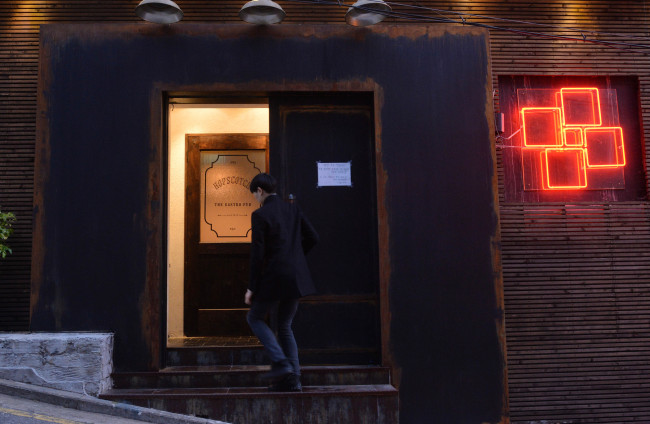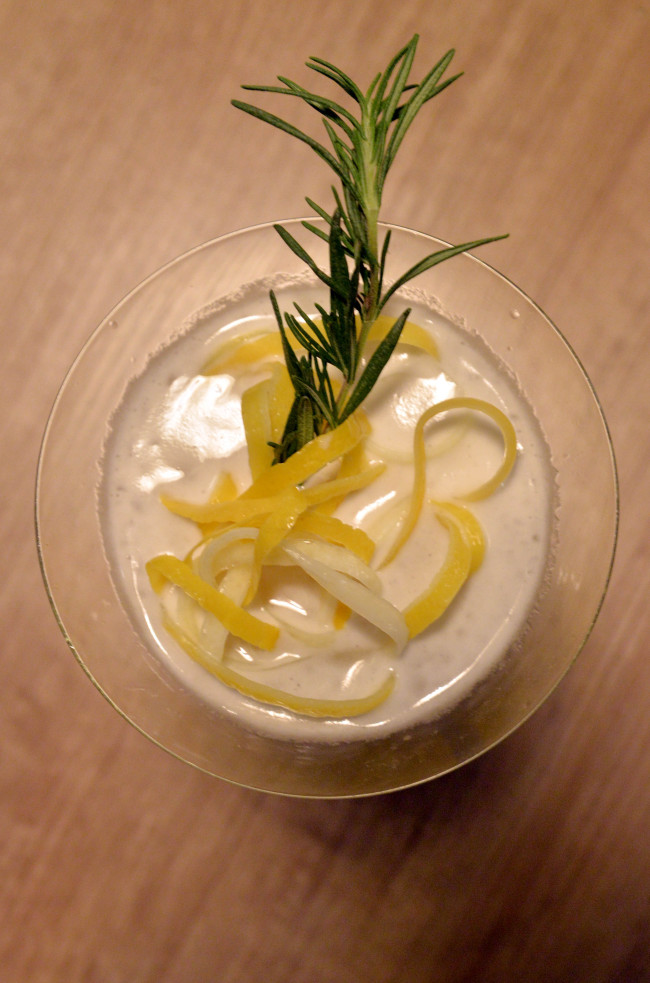
|
With no written signage, patrons have to find and figure out how to enter the deliberately incognito Hopscotch. Hint: Pull back on the heavy metal door. (Lee Sang-sub/The Korea Herald) |
Try inviting a friend over for a tipple at Hopscotch, and you may end up waiting as said pal gets lost.
Tucked away on a small backstreet with no written sign or obvious door, this retro gastropub is more than hard to find, it is deliberately incognito.
“We didn’t want the public to know about it,” said Hopscotch chef and co-owner David Cho.
The whole set-up might read anti-social to the extreme not to mention bad for business, yet, as Cho so charmingly puts it, “People want to find the small hole in the wall.”
“Small hole,” however, does not do justice to Hopscotch’s old-fashioned-with-a-twist decor, choice of jazz and eclectic selection of libations that range from single malt scotch to Belgian Trappist beer.
Of the decidedly retro vibe, Cho explained, “It’s supposed to be industrial going back to the ’20s and ’30s.”
Cho also revealed he was influenced by his own personal penchant for the Rat Pack era ― think Frank Sinatra and Dean Martin ― and jazz of the 1960s.
Despite the nod to the past, there was no intention, Cho said, to reference the speakeasy ― that relic of America’s 1920s and 30s Prohibition Era, when alcohol was illegal and therefore sipped in hidden spots protected with secret passwords.
Yet there is no mistaking Hopscotch’s under-the-radar, pre-21st century, scotch-touting ambience that many refer to as the speakeasy-style bar, a label that has been liberally slapped on other Seoul hotspots like Speakeasy Mortar and Vault+82.
The speakeasy-style bar, according to a liquor and spirits industry insider, is forging a new type of watering hole culture, a culture that appeals to patrons of the classic hotel bar, serious enthusiasts who want to enjoy their drinks in a quiet and posh environment with great service.
As the insider, who requested to remain anonymous, put it, today’s speakeasy bar attracts “fans of single malt whisky and classic cocktails” who want a private hideaway where the service is excellent and one can easily strike up a conversation with bartenders and mixologists while mulling over one’s drink.
In short, the only elements that truly seem to connect the nouveau speakeasy to its ancestor are that sense of being hidden, of taking one back in time and, of course, the tendency to play jazz as one’s bar music of choice.
So, why are bar patrons frequenting these new, so-called speakeasy-style bars?
“They make people feel special,” said Hopscotch’s Cho, elaborating that people want “something very exclusive, very unique; private.”
As for the tendency for these types of establishments to serve and specialize in single malt whisky, it all ties in with the desire for exclusivity, for something one-of-a-kind.
Each single malt is crafted at one specific distillery making it “harder to get, harder to find,” according to Cho. “It is the best thing you want to get in the most exclusive place you want to be.”
That one-of-a-kind attitude translates directly into the bars themselves and to their owners.
For instance, Hopscotch, which opened in Nonhyeon-dong this April, is specifically meant to channel a 1920s vibe.
 |
Zuidam 5-year jenever forms the base of Hopscotch’s Mister Bear cocktail. (Lee Sang-sub/The Korea Herald) |
The drinks menu centers on Cho’s and his co-owner’s favorite libations, beer and scotch, but does not stop there, also serving liquor like jenever, the Dutch godfather of gin that hails from the Netherlands and Belgium.
One might think that Cho and team would try to market a drink like jenever, giving it a prominent place on the menu to spur sales, but it takes a true fan of the sweet, ambrosial juniper-flavored liquor to pick it out from its spot on the whisky-by-the-glass page, where both Zuidam and Rembrandt jenever are listed.
For some reason, that obscure attitude actually falls right into place with Hopscotch’s off-the-radar vibe.
As befits a gastropub, there are also plenty of New American eats on the menu, with juicy, plump shrimp with a parsley-and-cilantro-inflected Chimichurri sauce and the veggie tower, a carefully assembled plate of grilled vegetables with basil pesto and mozzarella.
In short, there is no pigeonholing Hopscotch and its grub or drinks. It is its own laidback, old-fashioned hideaway.
The same goes for B28, which first opened in Singapore approximately two years ago before launching a second bar in Seoul this March.
Only those in the know can easily find B28 at its near-invisible basement location in Cheongdam-dong.
There is no written signage outside and even the trip downstairs to the establishment’s front door is forbidding, with a plaque halfway down warning would-be patrons of the dress code, the 10,000 won cover charge and the management’s right to refuse entry.
One might scoff at the dress code, but, as a matter of fact, co-owner Mike Soldner revealed that there have been many instances where people have been turned away since the Seoul bar opened some eight months ago.
“We’re serious about our dress code,” said Soldner, 35, adding that he would have also liked to put a lock on the door, which looks difficult enough to open as it is, if he could.
Why all the rules?
Soldner explained that he was not going for a speakeasy vibe with all the restrictions but merely wanted to ensure that his clientele was “coming here for a reason,” that reason being to enjoy Cuban cigars, single cask single malt scotch and special libations like B28’s barrel-aged cocktails, which have been matured in charred American oak.
Those who have been to B28 will probably get a circa 1950s to 60s vibe from the music, the decor and more particularly by perusing the cocktail menu, which serves classic drinks like the South Side cocktail, which, according to the menu, reportedly comes from the Prohibition era, and the 1900’s tipple, the Aviation.
In fact one will have trouble finding cocktails created after the 1960s, because, as Soldner put it, the concept “is that everything ties within the same basic snapshot in history.”
That time period was when “classic cocktails actually became widely known,” jazz was the “pop music” of that period, Cuban cigars were “huge” and scotch was “back in fashion.”
As for the retro hideaway being in vogue in Korea, Soldner agreed there is a trend toward more single malt scotch-serving, hard-to-find watering holes here, saying, “I got here a year ago, there were maybe three bars in our category. Now there are 10.”
Hopscotch
 |
Hopscotch mixologist Ahn Tae-sun pours Zuidam 10-year jenever. (Lee Sang-sub/The Korea Herald) |
113-20, Nonhyeon-dong, Gangnam-gu, Seoul
(02) 511-0145
Open 6 p.m. to 2 a.m. daily, closed Sundays
Single malt whisky by the glass costs 12,000 won to 21,000 won, bottled beer costs 10,000 won to 40,000 won
B28

|
From its hard-to-find perch in Cheongdam-dong, B28 channels a subterranean, neo-1950s to 60s vibe with its selection of Cuban cigars, single malt whiskies and classic cocktails. (Kim Myung-sub/The Korea Herald) |
Basement 88-2, Cheongdam-dong, Gangnam-gu, Seoul
(010) 3402-2828/ www.BTwentyEight.com
Open 7 p.m. to 4 a.m. daily
10,000 won cover charge; single malt whisky by dram (40 ml) costs 20,000 won to 465,000 won; barrel-aged cocktails cost 28,000 won
By Jean Oh (
oh_jean@heraldcorp.com)









